
Leonard Gale (d. 1690)
Leonard Gale, a young blacksmith from Sevenoaks, in Kent, came to Crawley in the 1680s. He become one of the most successful ironmasters in Sussex. He died in 1690. His son, also called Leonard, inherited his father's estate, and in 1698 he bought the Crabbet Park estate in Worth. His daughter, Sarah, who was his heir, married Samuel Blunt in 1750, and the Crabbet estate passed into the Blunt family.
Elizabeth Fry (21st May 1780 - 12th October 1845)
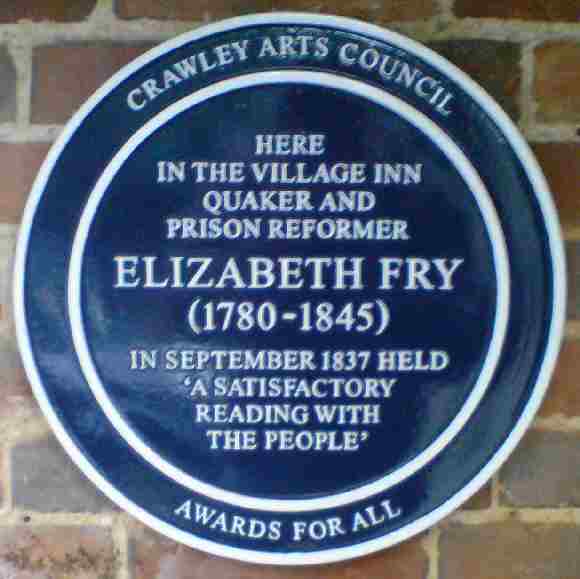
Elizabeth Gurney was born in Norwich, the daughter of Quakers. Her father was a partner in Gurney's bank and her mother, who died when Elizabeth was 12, came from the Barclay's banking family. Influenced by the preaching of an American Quaker, William Savery, she began her charitable work when she was 18. She married Joseph Fry - nephew of the founder of the chocolate and confectionery company - on 19th August 1800 and moved to London. They had eleven children.
She became involved with prison reform after a visit to Newgate prison. She was horrified by the conditions, particularly of the women and children. She eventually founded a prison school, organised supervision for the women and in 1817 was involved in the founding of the Association for the Improvement of the Female Prisoners. She persuaded the Home Secretary, Sir Robert Peel, to introduce prison reforms. She also became involved in other philanthropic work, including establishing a night shelter for the homeless in London and opening a training school for nurses. She travelled extensively to prisons all over the country, helping with the formation of local associations and taking up issues with local authorities; her influence even spread abroad. Her work was curtailed when her husband became bankrupt, but she managed to continue with the help of her brother-in-law.
In 1837 she gave a lecture at Old Plough Cottage, Ifield Street, Ifield, where a plaque has been installed. She died in Ramsgate and was buried in the Friends' cemetery at Barking. In 2002 the Bank of England selected Elizabeth Fry to feature on the five pound note.
Doctor Thomas Smith
Dr. Thomas Smith lived and practised at the Tree House from 1828 to 1862. Dr. Smith was succeeded by Dr. Timothy Martin.
Sarah Robinson (1787 - 1875)
Sarah Robinson was a Quaker and she lived in Manor Farm House, County Oak. The house was demolished after the war and the grounds are now part of the Manor Royal industrial estate. She was responsible, amongst other things, for raising funds for and establishing Crawley and Ifield Cottage Hospital, and she founded a charity school in 1827. In commemoration a plaque was placed on a house in Victoria Mews, West Green.
Francis Blunt (c. 1790 - 17th December 1842)
Francis Blunt, a local magistrate and landlord, married, at the late age of 48, the 32 year-old Mary Chandler. His death in 1842 left Mary with three young children, Francis, Wilfred and Alice (born on 4th January 1842). Mary, who was strongly religious, entered, with her three children, the Roman Catholic church. Mary died of consumption on 3rd June 1855, and Alice died on 17th August 1872.
Mark Lemon (30th November 1809 - 23rd May 1870)
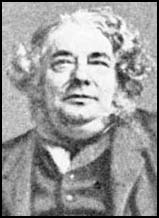

Mark Lemon worked in publishing and journalism in London and he was the founder and editor of the magazine Punch. He lived in Vine Cottage at the southern end of Crawley High Street from 1857 until his death in 1870, and commuted from Crawley to his office in Bouverie Street. He was one of those responsible for the establishment of Crawley Fire Brigade in 1866. His involvement in other local activities included the Cricket and Rifle Clubs, amateur concerts, theatre and readings, and he also arranged art exhibitions.
On 7th August 1866 the people of Crawley gathered in the Station Inn's Assembly Rooms to present Mrs. Lemon with a silver tea service which was engraved with the words Presented by the inhabitants of Crawley and To Mark Lemon, as a token of affectionate regard . He is buried in Ifield churchyard. In commemoration a plaque was placed at The George.
Sources & Further ReadingThe Times, 24th and 30th May 1870
John Leech (1817 - 1864)
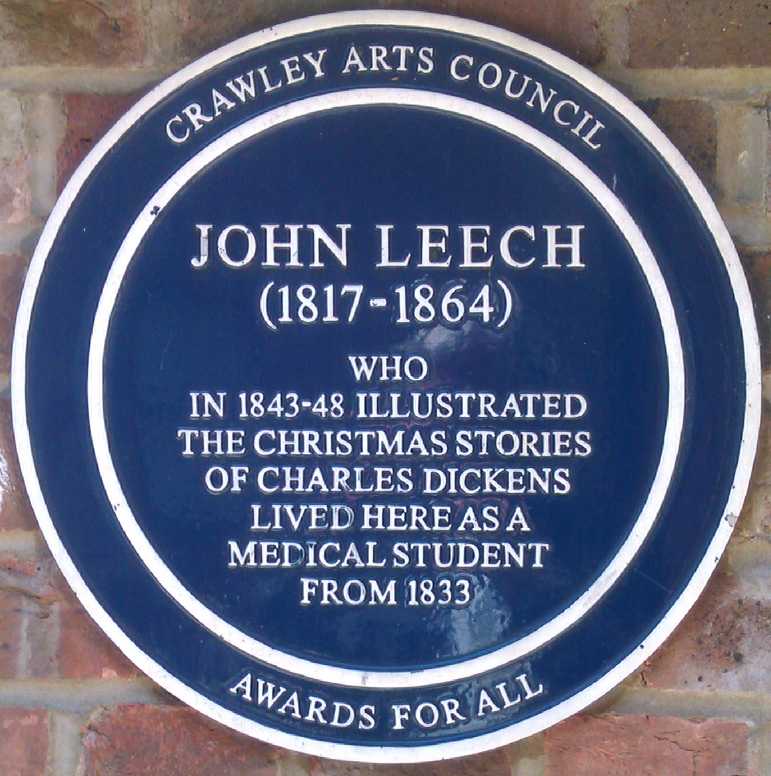
John Leech joined the practice of Dr. Thomas Smith as a medical student at the age of 16, about 1830. However, he showed great skill as an artist, spending hours drawing horses on his white-washed bedroom wall. In 1834 he went to London to pursue a career as an artist, where he became illustrator to Charles Dickens. From 1842 he was chief illustrator and cartoonist for Punch magazine, which was founded and edited by Mark Lemon, a Crawley resident from 1857. Leech returned to Crawley in 1862 for the marriage of Lemon's daughter, Alice, to Dr. Timothy Martin. A plaque dedicated to John Leech is on The Tree in the High Street.
Robert Whitehead (1823 - 1905)
Inventor, in 1866, of the self-propelling torpedo. He is buried at Saint Nicholas Church, Worth.
Philip Webb (1831 - 1915)
Philip Webb designed Standen in East Grinstead, now a National Trust property, and Red House in Bexleyheath. He co-founded with William Morris the Society for the Protection of Ancient Buildings. A plaque was installed at Caxtons on the Turners Hill Road where he lived after his retirement between 1900 and 1915.
James Longley (6th June 1836 - 1915)
James Longley was born in Worth. He founded the family building business of James Longley & Sons in 1888.
Doctor Timothy Martin (25th May 1837 - 5th November 1917)
Dr. Timothy Martin, from Merthyr Tydfil, became Dr. Thomas Smith's assistant, taking over the practice in 1862. In 1862 he married Mark Lemon's daughter, Alice. In 1914, shortly before his death, Dr. Martin wrote a history of the Tree House in the High Street and its famous occupants.
Catherine Walters (13th June 1839 4th August 1920)
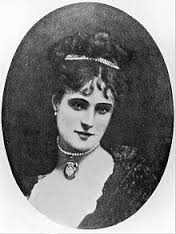
'The last of the Victorian courtesans', Catherine Walters was the great love of Wilfred Scawen Blunt, who remained infatuated with her for the rest of his life. Born in Liverpool, she was described as possessing classical beauty; she was also one of the era s most elegant horsewomen. Her nickname, "Skittles", is thought to have originated after briefly working in a bowling alley in Mayfair. Her benefactors included Emperors, Prime Ministers, Dukes and several members of the British royal family including the future King Edward VII. She was discreet and loyal to her many lovers earning her a lifetime of annual stipends. She died at her home in Mayfair, and was buried in the graveyard of the Franciscan Friary, in Crawley.
Francis Scawen Blunt (14th June 1839 - 21st April 1872)
Francis Blunt was responsible for the establishment of the Friary of St. Francis of Assisi in 1861. He died of consumption, aged 32, and was laid to rest in the Friary Church, in a tomb covered by an effigy of him dressed in the robe of a Capuchin Friar, sculpted by his brother, Wilfrid.
Wilfrid Scawen Blunt (17th August 1840 - 10th September 1922)
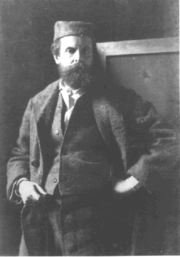
Wilfrid Blunt was born at Petworth. He was an eccentric who spent his earlier years in Egypt and had a passion for Arab horses and culture.In 1869 he married Lady Anne Noel. Wilfrid inherited the Crabbet Park estate on his brothers death in 1872. In 1873 he replaced the original Tudor house with the present mansion, which was built largely of Sussex materials. In the same year his only surviving child, Judith Anne Dorothea, was born.
The first of the Arab horses, founding the world famous Crabbet Arabian Stud, arrived in 1878, and Wilfrid would often dress in Arab garb riding around his estate. Guests at Crabbet Park included Oscar Wilde and Winston Churchill. His later years were spent mostly at his Newbuildings estate, near Horsham, were after his death he was interred, without any religious ceremony, in a rolled up carpet in the grounds. He passed his estate to his daughter, Judith, in 1907, fifteen years before his death. Lady Anne was buried in a catholic cemetery near Cairo. The disgraced spy Anthony Blunt was an ancestor of Wilfrid.
Sources & Further ReadingA Pilgrimage of Passion: The Life of Wilfred Scawen Blunt, Elizabeth Longford, Weidenfeld and Nicolson (1979), reprinted by Tauris Parke Paperbacks (2007)
The Times, 12th and 13th September 1922
Phillip Saillard
Philip Saillard bought the Buchan Hill estate and built a new house there.
John Nix
John Nix, a leading banker in the City, bought the Tilgate estate about 1863 and rebuilt the mansion there.
James Pulham (1845-1920)
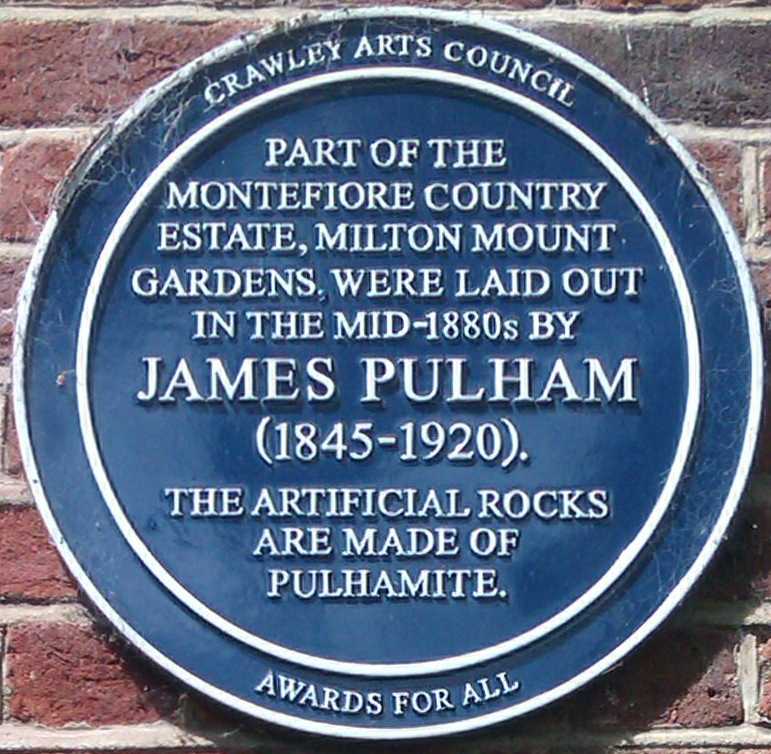
In the 1880s James Pulham designed and laid out the gardens at Worth Park for Sir Francis Montefiore. The artificial stone and rock he used was known as Pulhamite. He also designed the rock gardens at Sandringham and Buckingham Palace. A plaque was placed outide Milton Mount Community Hall.
Sources & Further ReadingRock Landscapes: The Pulham Legacy, Claude Hitching, Garden Art Press
Reverend John Barrett-Lennard (d. December 1898)
Rector of Crawley from 1876 to 1898.
Charles Mitchell
Charles Mitchell succeeded his father, William, as Crawley's postmaster in 1876. Charles retired in August 1908 and was presented with a clock and an illuminated address which bore the inscription We, the undersigned, mindful of your long and faithful service as Postmaster of Crawley, desire to record our deep regret at the severance of ties which have existed for so many years, and as a token of our appreciation of the kind and courteous manner in which you have always discharged your duties . He moved to Oak Lodge in Post Office Road. His only son, Kenneth, was injured during the First World War and died in 1915 in a sanatorium on the south coast. He is buried under a headstone of the Commonwealth War Graves Commission in St. John's churchyard.
Richard Marsh (12th October 1857 - 9th August 1915)
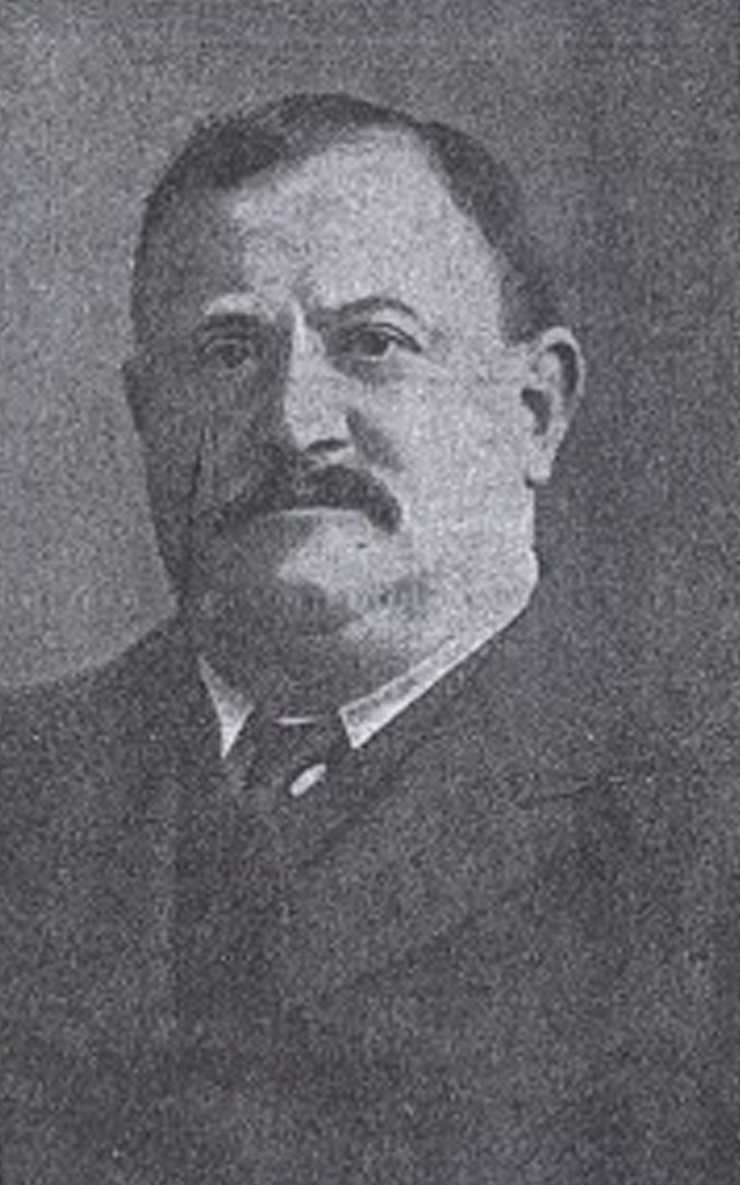

Born as Richard Bernard Heldmann in St John's Wood, Richard Marsh was a prolific author best known for his supernatural thriller The Beetle (1897) (at the time outselling Bram Stoker's Dracula which was published in the same year). Shortly after his birth his father, Joseph Heldmann, became involved in bankruptcy proceedings and abandoned his career as a merchant, becoming a schoolmaster in Hammersmith.
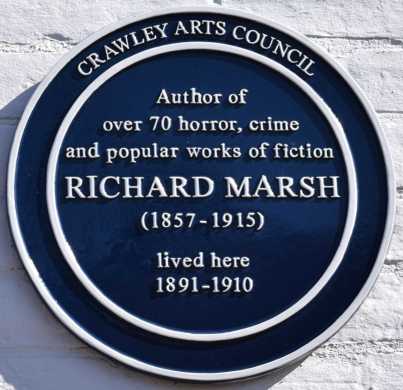
From 1880 Richard Heldmann wrote fiction - mostly boys' school and adventure stories - for various periodical publications, and in October 1882 he was promoted to co-editor of the boys' weekly Union Jack. However, during 1883 he issued a number of forged cheques for which he was sentenced to eighteen months hard labour in April 1884.
On his release Heldmann adopted the name Richard Marsh - using his mother's maiden name. During 1888 he began writing under this pseudonym for periodicals, and published two novels during 1893; he became a popular author of fiction, including crime, detection, thriller, horror, romance, and humour.
In 1891 he moved to a house called Sunnyside, 53 New Street, Three Bridges - were a plaque has been placed - before moving to Haywards Heath in 1910. He died from heart disease in Haywards Heath in 1915.
Baroness Nessler (1858 - 13th March 1935)
Alice Felix Louise Nessler lived at Brookside, Tinsley Green. She was the daughter of Matthew Cantlon and married General Henry Nessler of Lübeck.
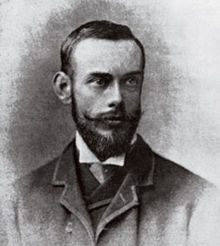
Francis Thomson was born in Preston, Lancashire. He studied medicine, his father was a doctor, but without any real interest and instead he moved to London, where he lived as a vagrant and became addicted to opium. He submitted some of his poetry to the magazine Merrie England, which the editor, Wilfrid Meynell, published. Wilfrid Meynell rescued him from his destitution and he subsequently lived in Storrington, Wales and London, continuing to write and publish his work. Near the end of his life he was befriended by Wilfrid Blunt and he lodged at 11 Victoria Road, West Green, where a plaque has been installed. He died in London of tuberculosis.
Sources & Further ReadingFrancis Thompson: In His Paths, a Visit to Persons and Places Associated with the Poet, Terence L. Connolly, Bruce Pub. Co., Milwaukee (1944)
Francis Thompson and Wilfred Meynell, Viola Meynell, Hollis & Carter (1952)
Francis Abraham Montefiore (10th October 1860 - 1st July 1935)
Francis was a second cousin if the first Lord Rothschild, and was educated at Wellington College and Christ Church, Oxford. He succeeded his father, Joseph Meyer Montefiore, inheriting the Worth Park estate. His great-uncle, Sir Moses Montefiore died in 1885 without an heir, and the baronetcy was revived in 1886 in favour of Francis. In 1888 he married Marianne, daughter of Baron Welhelm von Gatmann of Vienna, but they had no children. He was president of the English Zionist Federation, but resigned on the outbreak of the First World War. He later became president of the Elders of the Spanish and Portuguese Jewish Community of London. Sir Francis died in 1935 and the baronetcy expired. The funeral was held at the Spanish and Portuguese Jews' Cemetery, Mile End Road, on 3rd July 1935.
Sources & Further ReadingThe Times, 2nd and 5th July 1935
Moses Nightingale (1861 - 1934)
Moses Nightingale was born in 1861 at Tushmore. He was the son of a brickmaker, and he started work in the family business but lasted only a few days. He worked for several months as a telegraph boy at Three Bridges Station before being apprenticed to a coal and corn merchant. In 1882 he set up in business with James Fillery. Ten years later James Fillery died and Moses Nightingale's son later became a partner.
He married Ruth at St. John's church on 23rd April 1884. He was the secretary of the Crawley and Ifield Harmonic Society and in 1884 founded the Hazeldene Orchestra. He was involved in many local activities including the parish church and water company. In 1896 he built a house, Hazeldene, in the Brighton Road, which is now the Crawley Club. Moses and Ruth celebrated their golden wedding anniversary in 1934 and died shortly after. They are buried in Saint John's churchyard.
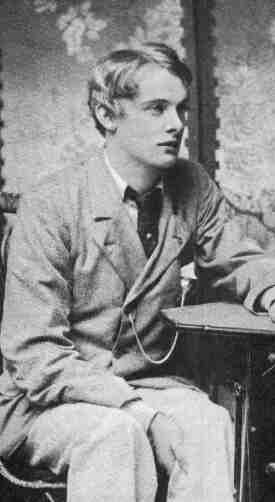
Lord Alfred Douglas, poet and writer, was born on 22nd October 1870, the third son of the 9th Marquess of Queensberry. Bosie - he preferred to be called by his childhood nickname - was educated at Magdalen College, Oxford, where he met Oscar Wilde. After meeting his son and Wilde outside the Cafe Royal in 1894 his father threatened to disown him, unless he ceased his association with Wilde. The Marquess sent a card to Wilde at the Albemarle Club, accusing him of "posing as a somdomite" (sic), and subsequent legal actions resulted in Wilde's trial in 1895 and imprisonment for two-years hard labour.
Bosie married Olive Custance in 1902, and in the same year they had a son, Raymond. In 1911 he converted to Roman Catholicism. In 1913 his wife left him, taking their son with her. In 1924, he pursued legal action against Winston Churchill, who in turn prosecuted Bosie for criminal libel. Bosie lost the case and was sentenced to six months imprisonment.
His wife died of a cerebral haemorrhage in February 1944 at the age of 67, and Bosie died in Lancing of congestive heart failure on Wednesday, 20th March at the age of 74. He was buried at The Franciscan Friary, in Crawley, next to his mother's grave, with one gravestone covering both.
Sources & Further ReadingThe Times, 21st and 24th March 1945
Judith Blunt Lytton, Lady Wentworth (6th February 1873 - 1957)
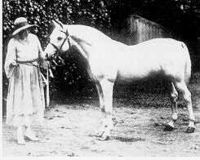
Judith Blunt married Neville Lytton, son of the first Viceroy of India, in 1898 and in 1904 they moved into Crabbet Park with their three children. However, in 1923 her marriage ended in divorce. In 1907 Wilfred Blunt passed his estate to Judith fifteen years before his death, and in 1916 she sold most of it, leaving only the house and some adjacent land. In 1917 she became Baroness Wentworth, holding the title in her own right on the death of her mother. Her writing ranged from poetry including Love in a Mist (1913) and War Nonsense (1940), to her most famous book, The Authentic Arabian (1947). Lady Wentworth is buried in St. Francis churchyard.
Sources & Further ReadingThe Times, 10th, 15th and 19th August 1957
The Times, 2nd, 7th and 9th May 1940
John Hobbis Harris, Crawley Museum Society Society Newsletter No. 4, Winter 1990
Reverend Herbert Loraine Barrett-Lennard
Son of Reverend John Barrett-Lennard 'Bertie' Barrett-Lennard studied at Cuddesdon Theological College, and was ordained Deacon at Peterborough in 1888, becoming a priest a year later. He became Rector of Wickford in 1898, taking over the living of Crawley on the death of his father the same year until his resignation in 1929. On his retirment he moved into 'Glenmore' in Brighton Road.
Una Pope-Hennessey (1876 - 1949)
A biographer, including those of Charles Dickens, Charles Kingsley and Edgar Allan Poe. She is buried at The Franciscan Friary, in Crawley.
William James Denman (1877 - 1945)
William James Denman was born in 1877 above an antiques and second-hand shop in the High Street; his family then moved to a house in Station Road. He left school when aged 12, and in 1894 joined the Post Office, becoming head postman by 1924. He became a reporter for several local newspapers. He was involved with local clubs and voluntary organisations including Crawley Football and Cricket clubs, becoming chairman of both. He also became chairman and president of Crawley Labour Party, which was launched at a meeting in his house. In December 1932 he was appointed a magistrate. He died just after VE day in 1945 aged 67.
Sir Malcolm Campbell (11th March 1885 - 31st December 1948)
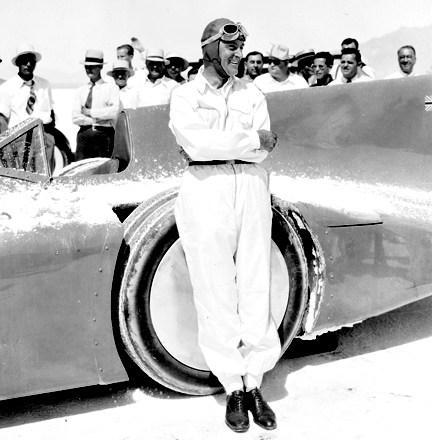
Malcolm Campbell was born in Rossmore on Chislehurst Common, the son of a diamond merchant.
In 1924 at Pendine Sands, Pembrokeshire he gained the land speed record of 146.16 mph in Bluebird, the name he used for his land and water vehicles. In 1925 he achieved a land speed record of 150 mph, and he and his rival, Henry Seagrave, held the record alternately over the next ten years. Malcolm Campbell was the first man to exceed 300 mph on 3 September 1935 on Bonneville Salt Flats, Utah.
In 1937 he gained the water speed record at 129 mph, and on 19th August 1939, at Coniston Water in the Lake District, he achieved a speed of 141.7 mph, a record which he kept until his death. He had a cottage by Tilgate Lake which he used in the 1940's for flotation trials for his speedboat Bluebird. A plaque was installed at Tilgate Lake - known locally as Campbell's Lake.
He died on 31st December 1948, in Reigate.
Sources & Further ReadingThe Times, 3rd and 7th January 1949
Caroline Haslett (17th August 1895 - 4th January 1957)
Caroline Harriet Haslett was the eldest daughter of Robert Haslett, a railway signal fitter and pioneer in the Co-operative movement, who lived in Three Bridges. Caroline Haslett was born in Worth on 17th August 1895, was educated at Haywards Heath High School, and went on to qualify in general and electrical engineering. She was a member of the Women's Engineering Society, becoming its first secretary in 1919, and was founder of its journal, The Woman Engineer , which she edited for many years. The society founded the Caroline Haslett Trust, providing scholarships and travelling fellowships for domestic science teachers. In 1924 she founded the Electrical Association for Women , and was director until 1956.
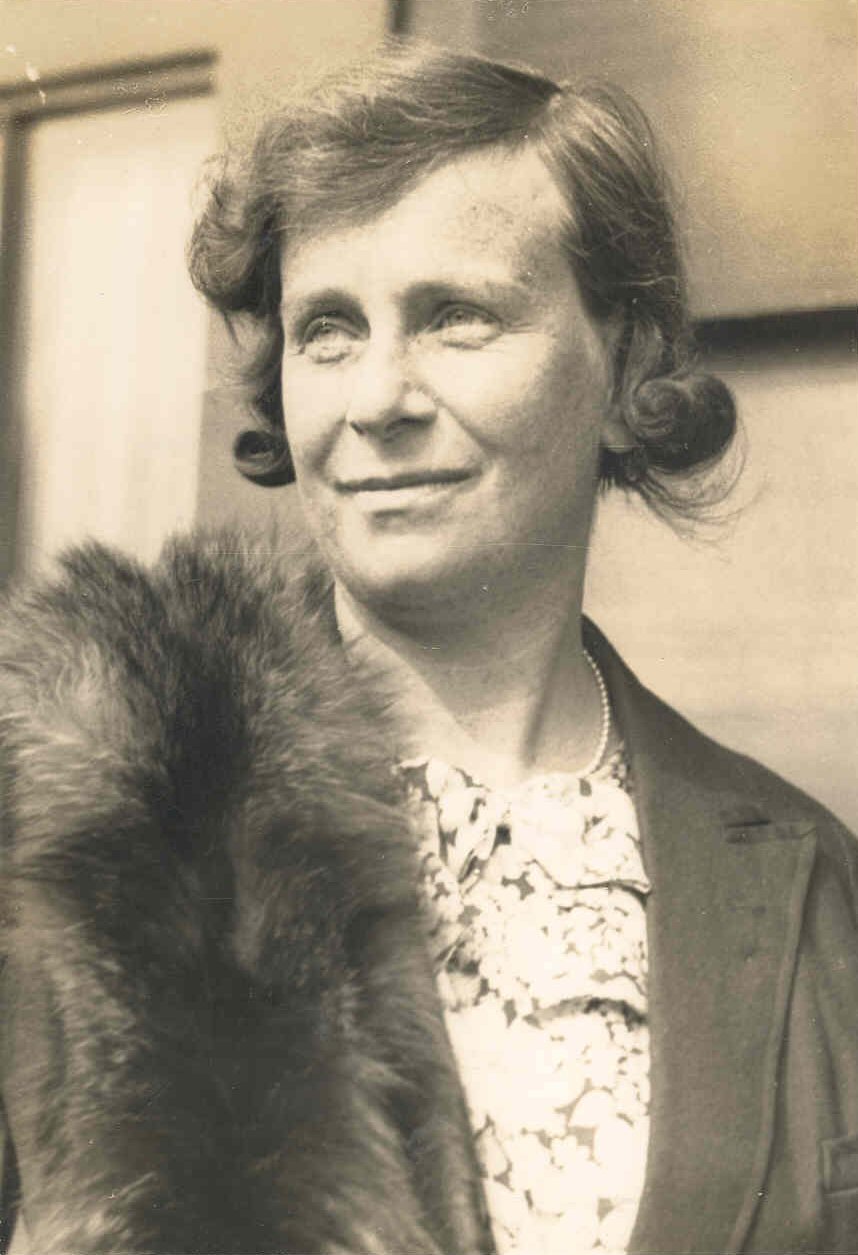
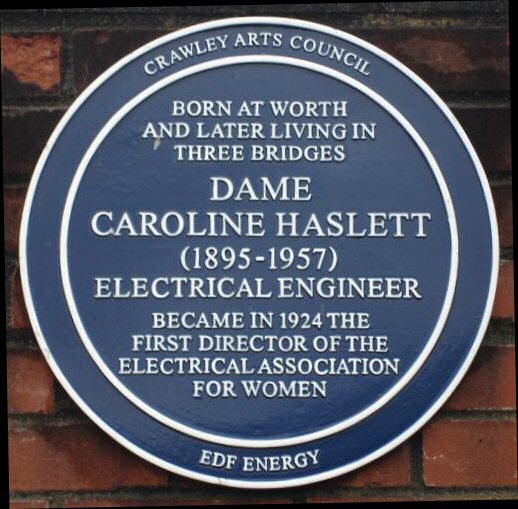
She worked to break down the prejudices of employers against taking on female workers, and persuading engineering institutions to allow women to qualify. She was associated with the development of the domestic uses of electricity, editing the Electrical Handbook for Women and Household Electricity .
She was a member of many organisations including the Council of the British Institute of Management, the Industrial Welfare Society, Royal Institute of International Affairs, Royal Institution, the first woman to be made a Companion of the Institute of Electrical Engineers, chairman of the Council of Scientific Management in the Home, the first woman vice-president of the Royal Society of Arts, chairman and president of the British Federation of Business and Professional Women, the first British president of the International Federation of Business and Professional Women, and served on the governing bodies of various educational institutions.
In 1931 she was made a Commander of the Order of the British Empire for her services to women, and in 1947 was promoted to Dame Commander. She was appointed by the Minister of Fuel and Power in 1947 as a part-time member of the British Electricity Authority, formed to conduct the industry under national ownership. She became a member of Crawley Development Corporation at its inception in 1947, retiring due to ill health in 1955, and a Justice of the Peace for London in 1950.
Dame Caroline died on Friday, January 4th 1957, at her home in Bungay, Suffolk, where she lived with her sister, Mrs. Rosalind Messenger. A plaque, sponsored by EDF Energy, marking the 50th Anniversary of Dame Caroline's death was placed at the entrance to one of their sub-stations near the junction of Haslett Avenue East and Three Bridges Road as part of Crawley's heritage trail.
Sources & Further Reading
Sussex & Surrey Courier, 30th September 1939
The Times, 5th, 10th and 26th January 1957
Crawley Observer, 11th January 1957
The Doors of Opportunity: A Biography of Dame Caroline Haslett DBE Companion IEE, Rosalind Messanger (Femina Books, 1967)
Noel Anthony Scawen Lytton, Baron Wentworth (7th April 1900 - 18th January 1985)
Noel Anthony Scawen Lytton was born on 7th April 1900, the son of Neville, the Third Earl of Lytton, and Judith Blunt. His grandfather, Edward, the First Earl, was also the first Viceroy of India. He was educated at Sandhurst, where he later taught economics, and he served as an administrator and keeper of the peace in the area around Lake Rudolph in Kenya. During the Second World War he served in Italy, Africa and Greece, and spent much of his life abroad. He met his wife, Clarissa Palmer, in Italy and they married in 1946 and had five children. He was a writer, publishing two novels as well as his autobiography, "The Desert and the Green" and a biography of his grandfather, Wilfrid Scawen Blunt. He succeeded his father as the 4th Earl of Lytton in 1951 and inherited his mother's title as Baron Wentworth on her death in 1957.
Sources & Further ReadingThe Times, 23rd January 1985
Sir Norman Longley (1900 - 1994)
Norman Longley was born in Rathcote, Goffs Park Road, in 1900. His grandfather, James Longley, founded the family business which Norman joined 1923, becoming joint Managing Director in 1931 on the death of his father.
Geraldo - Gerald Bright (10th August 1904 4th May 1974)
Gerald Bright was born in London, the son of a City Master Tailor. He studied the piano at the Royal Academy of Music, became a cinema pianist accompanying silent films and his broadcasting career began in the 1930s with a light orchestra in Blackpool. He studied Latin-American rhythms in South America. In 1930 he adopted the name Geraldo and became one of the most popular British dance band leaders during the 1930s and 1940s. He was a founder director of Harlech Television and a former musical director of Scottish Television.
He played an active part in Crawley Arts Council, including as its President, and as an adviser to the Crawley Arts Festival. He lived with his wife at Crabbet Park, Worth. He died of a heart attack whilst on holiday in Vevey, Switzerland aged 69.
Sources & Further ReadingCrawley Observer, 10th May 1974
How I Chose Crawley Street Names, John Goepel (Crawley Museum Society, 1980, 1993)
The Development of Crawley New Town, John Goepel (Crawley Museum Society, 1980, 1993)
John George Haigh (1909-1949)
Dr. Theodore Siklos (1911-15th December 1984)
Theo Siklos (formerly Theodore Stern) was a Hungarian immigrant naturalized in 1947. He was the first Principal of Crawley College of Technology (1957-1976).
Charles Walter Michael Court, 29th September 1911 22nd December 2007

Charles Court was born in Crawley, his family emigrating to Perth, Australia, when he was six months old. He joined the Liberal party in 1946 and served as Premier of Western Australia from 1974 to 1982.
Daisie and Florrie Warren
Daisy and Florrie Warren took over their fathers ironmonger's shop in the High Street and ran the business until they moved to Arundel in 1955 following the compulsory purchase of their property . Both were tireless fundraisers for local causes, and Daisy was a Parish Councillor, who in 1950, was presented to Princess Elizabeth when opening the Manor Royal Estate. She was an expert on fine porcelain, pottery, table and decorative glassware, and cut crystal. Before her death in 1979 Daisy recorded her recollections of the town in writing and on tape, and her archives, consisting of a mountain of papers, writings, notebooks, ledgers and photographs, were given into the care of Sir Norman and Lady Longley.
Frederick Knott (1916 - 2002)
Born in Hankow, China, where his parents were missionaries, Frederick Knott was sent to England in 1926. He was educated at Oundle School, Northamptonshire, and Cambridge, earning a degree in law. He served as a signal operator during the war, rising to the rank of major. He lived with his parents in Little Balgair, a house in Langley Lane which they had bought in 1948, but has since been demolished. Here he wrote the play Dial M for Murder, which in 1954 became a film by Alfred Hitchcock starring Grace Kelly and Ray Milland. He wrote two more plays, Write Me a Murder (1960) and Wait Until Dark (1966) which was released as a film in 1967 starring Audrey Hepburn. He moved to the United States in 1954 and died in New York. A plaque was placed on the wall of the Masonic Hall in Ifield Green by Crawley Arts Council.
Richard Browne (1921 - 1990)
Family Group by the Sussex sculptor Richard Browne was erected on the Co-Operative Society store (now Wilko) in the Broadway, and below it is a plaque dedicated to Richard Browne.
Peter Vaughan (4th April 1923 - 6th December 2016)
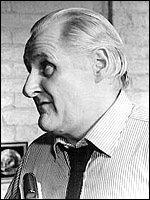
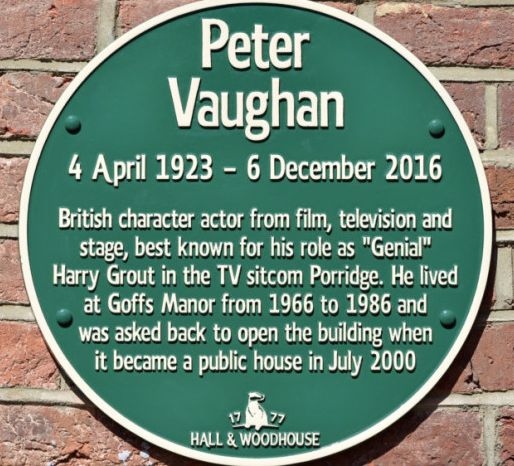
Peter Vaughan was born in Wem, Shropshire, as Peter Ohm, and is a character actor known for many supporting roles in film and television, as well as extensive theatre work. He made his film debut in 1959, but is perhaps best known as Grouty in the television comedy Porridge, starring Ronnie Barker. In 1952 he married the actress Billie Whitelaw, but was divorced in 1966 and later married the actress Lillias Walker. He lived in Goffs Manor before it was converted into a pub and restaurant. A plaque in his honour was unveiled at his former home in June 2017.
Sheila Mary Snelling - Mad Mary (13th September 1926 - 1995)
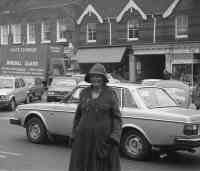
Mary Snelling was born in South Norwood, London, who lived in Trefoil Crescent, Broadfield between 1979 and 1995. She was an eccentric character who, rather unfairly, became known as 'Mad Mary'.
Nigel Calder (2nd December 1931 25th June 2014)
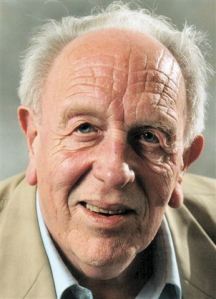
Born in London, he was the eldest son of Peter Ritchie Calder (later Lord Ritchie-Calder). After graduating from Cambridge and a brief research career at the Mullard Research Laboratories he joined the editorial staff of the New Scientist, becoming editor between 1962 and 1966. He made thirteen television documentaries including The Violent Universe (1969), The Restless Earth (1972) and Spaceship Earth (1991). In 1972 he was awarded the Unesco Kalinga prize for the popularisation of science. He lived in Furnace Green, and and was the father of travel writer Simon Calder.
Michael Hazlewood (24th December 1941 6th May 2001)
Mike Hazlewood was born in Cuckfield and educated at Hazelwick School. He joined Radio Luxenbourg as a DJ in the early 1960s and founded the group The Family Dogg with Albert Hammond and Steve Rowland in 1966. He wrote with Hammond songs such as Gimme Dat Ding for the Pipkins and The Air That I Breathe for Phil Everly. He died from a heart attack whilst on holiday in Florence.
Jim Pitts (22nd April 1942 4th May 2012)

Jim Pitts joined the band Brett Marvin and the Thunderbolts shortly after their formation in 1968 by students from Thomas Bennet School. They realeased a single, Seaside Shuffle, in 1972 under the name Terry Dactyl and the Dinosaurs, which reached number two in the charts, and appeared on Top of the Pops. Jim lived in Northgate. A plaque was unveiled at Northgate Community Centre, were Jim often performed, on 9th April 2015.
Roger Bastable (1950-2007)

Roger Bastable was born in 1950, his parents ran a fishmongers shop. He taught history at Holy Trinity School, and produced several books on the history of Crawley. He was a churchwarden at St John s Church, co-founded the Crawley Festival, was a founding member of Crawley Museum Society and founded the Mark Lemon Society. He died of cancer aged 56.
Alan Minter (17th August 1951 - 9th September 2020)
Alan Minter is a former professional boxer, born in Crawley. He won a bronze medal in the 1972 Munich Olympic Games and later held middleweight titles. He ran Minter's Restaurant & Wine Bar at the Ancient Priors, Crawley High Street, between 1977 and 1980, continuing under new management until 1983. He married Lorraine Bidwell, but they later divorced.
Simon Calder (25th December 1955 - )

Born in Crawley, Simon's father was the science writer Nigel Calder. Whilst working for British Airways he wrote budget travel guidebooks before studying Mathematics at University of Warwick. In 1994 he became travel editor for The Independent and began presenting for BBC2's Travel Show.
Daly Thompson (30th July 1958 -)
The athlete and Olympic gold medalist, Daly Thompson, was born in Notting Hill, London. He trained in Crawley and studied at Crawley College of Technology.
Robert Smith, Michael Dempsey, Porl Thompson and Lol Tolhurst - see The Cure
Gareth Southgate (3rd September 1970 -)

Born in Watford, Gareth Southgate is a former pupil of Hazelwick School. He played football for Crystal Palace, Aston Villa, Middlesbrough and England. In August 2013 he became manager of the England under-21 team and following the resignation of Sam Allardyce in September 2016, he was appointed as temporary England manager, which in November was confirmed as a four-year contract.
Yousseph Slimani - see Chico
Romesh Ranganathan (30th January 1978 -)

Romesh Ranganathan is a stand-up comedian and actor born in crawley. He went to Hazelwick school before studying Maths at Birkbeck College, University of London. He went on to teach maths and become head of sixth form at at Hazelwick School.
Sources & Further ReadingStraight Outta Crawley: Memoirs of a Distinctly Average Human Being, Romesh Ranganathan, Bantam Press (2018)
Kevin Jeremiah, Ciaran Jeremiah and Paul Stewart - see The Feeling
Dan Walker (19th March 1977 -)
The television presenter, Dan Walker, was born in Crawley, the son of a church minister. He attended Hazelwick School. His broadcasting career began in local radio in Sheffield, and after winning a competition for young sports commentators he started full time in radio then television in Manchester.
Katie-George Dunlevy (26th November 1981 -)
Katie-George Dunlevy was born in Crawley but now lives in Maidenhead. She lived in Gossops Green and attended Holy Cross Middle School. Katie, who is partially sighted, won a gold medal for the Ireland team riding in tandem with pilot Eve McCrystal at the 2016 Rio Paralympic Games.